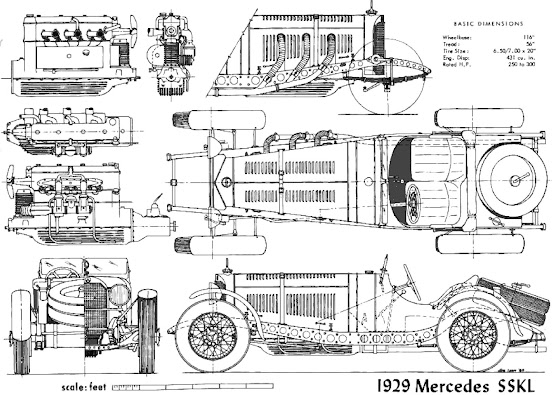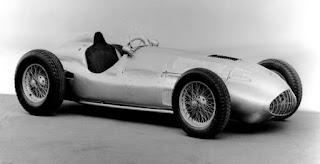Desmodromic (pronounced des-moh-drom-ick)
(1) In internal combustion engines, a valve drive-train
in which poppet valves are positively closed by a cam and leverage system,
rather than a conventional spring.
(2) By extension, in various mechanical devices,
a component having different controls for its actuation in different directions.
1953: A construct from the Ancient Greek δεσμός (desmós) (band, connection; fibrous connection, ligament; bond or knot) + δρόμος (drómos) (a course; travel; road). The etymology is likely oblique to all but mechanical engineers but denotes the characteristic of valves continuously being "bound" to the camshaft. The idea of desmo + dromic is thus often deconstructed as something like “running in unison” or “connected racing” but that’s because of the historic association with engines and speed and the desmo- prefix is also used in medicine and other biological sciences in the sense of “being or maintaining a connection”, a desmosome a filament-like substance with which cells adhere to each-other and desmoplakin" is the protein associated with this intercellular junction. In zoology, the term most closely analogous to desmodromic valve trains is desmopelmous, a type of foot in birds in which the hind toe cannot be bent independently because planter tendons are united (ie they are connected and work in unison).
Conventional valve activation (left) versus desmodromic (right).Probably as soon as there were poppet valves engineers began to ponder way of perfecting their opening and closing, the use of a spring for the latter effective but inexact and embryonic ideas would have been discussed but it was the German Daimler company which was first granted a patent for a desmodromic like valve-train system for a V-twin engine in 1889. After that, designs, prototypes and even the odd racing car appeared so equipped and while there was some success on the track, no manufacturer attempted mass-production because of the high costs inherent in the intricate design and, more practically, the formidably frequency with which the system demanded adjustment to maintain perfect operation. However, as the trophies won in competition had celebrated, the desmodromic arrangement uniquely permitted very high engine speeds and thus more power without the need to increase displacement and therefore bulk and weight.
A desmodromic valve schematic.
During World War II, there were great advances in
metallurgy and the design of internal combustion engines and one manufacturer
which had learned much was Daimler-Benz which had perfected the pressurized fuel-injection
system which early in the conflict had given Luftwaffe pilots some real
advantages over the allied opposition which continued to rely on primitive carburettors
for fuel delivery, these adversely affected by gravity while the German aircraft
were not. However, the valve-train relied
still on a spring to effect closing and this was a limitation which prevented
the advantages of fuel-injection being fully explored. The big aero-engines in the wartime Messerschmitts
has been low-revving so the valve-springs weren’t challenged by physics but the
company’s interest has returned to the race tracks and there, the systems
limitations were exposed, “valve-float” intruding at high engine speeds. The dreaded valve float is a phenomenon which
occurs at high engine speeds when valve springs can’t return the valves to
their seat with the cam follower still in contact with the cam. This means the valves can be launched too
high, even to the point where it can be still wide open when the piston arrives
at the top dead centre (TDC), something which in the worst case can result in impact
between the two, bending or even snapping the valve. That will often be catastrophic, the debris perforating
and possibly collapsing the hot aluminium piston head. From that point on, the damage caused will be
a matter only of extent, ranging from severe to complete destruction.
The Mercedes-Benz W196 Formula One Grand Prix (1954-1955) car used the desmodromic straight-eight in 2.5 litre form. A 3.0 litre version was created for the W196S (300 SLR) used in sports car racing.
That was something desirable to avoid in any
engine but especially so in a racing car because, as the saying goes, “to
finish first, first one must finish”.
Thus was designed Daimler-Benz’s surprisingly simple desmodromic system
for the Mercedes-Benz W196 Formula One car for the 1954 season, ruin under the
new 2.5 litre (152 cubic inch) displacement rule. An amusing mix of new (fuel-injection and the
desmodromics) and old (archaic swing axles and a straight-eight configuration),
it succeeded, dominating the World Championship in 1954-1955 and in 3.0 litre
form as the 300 SLR (technically the W196S), sports car racing too. One thing which proved vital in all this was that
the engineers had removed from the desmodromic hardware the small, final
closing spring which had previously been thought necessary. What the Daimler-Benz engineers discovered
was that if a residual clearance of a mere 0.03 mm (0.001181099 inch) was
machined, by simply leaving the return “desmo valve” in the closed position,
the inertia of the valve and the gas pressure in the cylinder was sufficient to
maintain the closure, a variation of the exploitation of the long-documented behaviour
of fluid dynamics Chrysler would soon market (somewhat opportunistically) as Sonoramic. The innovation was made possible by the development
of metals stimulated by the demands of war; in the pre-war years, the
desmodromic design adopted for the W196 simply wouldn’t have been possible.
The desmodromic valve control system used an opening cam which directly controlled a shoe at the upper end of the cylindrical tappet rod while another (closing) cam used a deliberately out-of-alignment rocker arm which engaged in a hole drilled in the same tappet. It was simple, precise and effective and reliably delivered such power that even Enzo Ferrari (1898-1988) considered matters desmodromic, discussing the matter with Dr Fabio Taglioni (1920-2001) who was working on the idea, his design first used by Ducati in 1954 on their 125 cm3 (7.6 cubic inch) racer and later adopted for many of their production and competition machines, used even to this day.
Lindsay Lohan with Ducati Monster 600 (Desmodromic) in Freaky Friday (2003).
Not needing return springs, the valves being positively opened
and closed by a cam and
leverage system, desmodromic offered higher engine speed, more power and a
variety of improvements to specific efficiencies. Despite that, except for Ducati, it never
became a system used by volume manufacturers (or indeed low-volume operations) because
of the disadvantages which included complexity, cost, noise (especially as the
cylinder count grew) and, critically, more frequent maintenance. It was advances in high-speed photography and
later computer analysis which rendered desmodromic an engineering
cul-de-sac. With a frame-by-frame view
of how valves and valve springs behaved, designers were able to engineer
solutions to the problems previously though inherent to conventional valve-trains
and, by the 1980s, vastly more powerful computers permitted the virtual testing
of every design permutation. Eventually,
the advantages offered by desmodromics became so small that few attempted to
justify to additional cost and maintenance penalty.
2002 Ducati MH900e (desmodromic).
What
the photography revealed was that valve float was caused mostly by resonance in
the springs which generated oscillating compression waves among the coils and
that at specific resonant speeds, the springs were no longer making contact at
one or both ends, leaving the valve “floating” before crashing into the cam on
closure. The solutions were varied and
some, such as Norton's “mousetrap” or “hairpin” spring were soon discarded because,
although they worked well, the engineering challenges in integrating them with
existing combustion chamber designs created as many problems as were
solved. A less elegant but more manageable
approach was to install as many as three concentric valve springs, sometimes
nested inside one other; not for more force (the inner ones having no
significant spring constant), but to act as dampers, both absorbing and reduce
oscillations in the outer spring (engineers delighting in calling the
additional springs “snubbers”). Again,
the advances in metallurgy made possible what was once though
unattainable. Complex valve springs were
engineered which did not resonate, being progressively wound with a varying
pitch varying diameter and dubbed “beehive springs” because of the shape. The number of active coils in these springs would
vary during the stroke, the more closely wound coils located at the static end,
becoming inactive as the spring compressed or (as in the beehive) where the
small diameter coils at the top were stiffer. Thus valve float was conquered with springs.
2023 Ducati Multistrada V4, the first Ducati in decades to use conventional valve activation.
But
Ducati persists to this day, their raucous machines, once a cult
known to a few now enjoying a wider audience which seems prepared to accept both the
frequency of with which valve-train adjustments are required and the inherent
clatter (which is admittedly quite spine-tingling if sampled at speed when wearing
a crash helmet). Tellingly, Ducati’s motor-cycles
are almost all V-twins because the noise level does become intrusive as the
cylinder count increases and their recent Multistrada V4 was the first in decades
to not use desmodromic valves, the owner rewarded, inter alia, with recommended maintenance intervals of 60,000 km (37,500
miles), a considerable advance on the traditional 12-18,000 km (7500-11,200
miles). Advances in engineering techniques have allowed the noise of the desmodromic arrangement to be reduced and there are now four-cylinder Ducatis using the system, appealing to those who lust for top end power. Among collectors of US muscle cars, Ferraris, Jaguars and such there are
those who can think of no more pleasurable way to spend a day than adjusting solid
valve lifters or tinkering with an array of carburettors (the fascination of intricacy its own reward), the synchronization
of which defy all but the chosen priesthood of such things so Ducati seems
likely to offer the devoted their desmodromics as long as such things remain somewhere lawful.





































